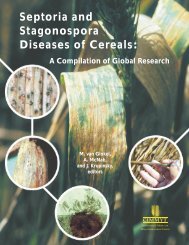Section 3 (Crop Management)
Section 3 (Crop Management)
Section 3 (Crop Management)
Create successful ePaper yourself
Turn your PDF publications into a flip-book with our unique Google optimized e-Paper software.
Gupta et al.<br />
were promoted in eastern and western Indian IGP in an Asian Development Bank funded project on<br />
sustaining rice-wheat rotation. Successful farmer participatory experiments in eastern IGP, in the state of<br />
Bihar, India, revealed number of profitable rice based cropping systems where maize could be grown in<br />
winter. Some of these rotations are given in Table 2 (Kumar, 2003). Among these rotations, rice-potatoonion-maize<br />
(green cobs) was found to be most profitable in south Bihar because of additional higher<br />
income from the green cobs. Similarly, rice-winter maize-potato gave highest net returns (USD 1011 ha -1 )<br />
in North Bihar. In comparisons involving traditional sole crop and intercropping of maize and potato on<br />
raised beds (RWC, 2003), intercrops performed better than the sole crops mainly due to the reason they<br />
were sown on flat fields in improper crop geometry, a common problem in these areas. Pandey et al.<br />
(2001) obtained highest net returns of USD 1473 per hectare by growing maize (for green cobs)-radishonion<br />
crop rotation under irrigated conditions. The next best system was found to be maize (for green<br />
cobs)-rice-cabbage with a net profit of USD 719 per hectare.<br />
Maize is a most versatile crop for growing intercrops, because of the wide row spacing it needs,<br />
providing higher income to the farmers. It was found that soybean and groundnut make good intercrops<br />
with maize (Prakash et al., 1993). Growing of maize + groundnut in 2:2 row proportion by paired row<br />
planting gave highest combined intercrop yield when compared to any other intercropping tested. In an<br />
experiment conducted at Narendra Deva University of Agriculture and Technology, Faizabad, Uttar<br />
Pradesh, the potato + maize intercropping in 2:1 ratio gave higher net returns than when sown in 1:1<br />
proportion. Though the potato-maize sequence gave the highest net returns in this experiment, farmers<br />
could be benefited by intercropping which gives similar returns in the single season as an added<br />
advantage (Singh et al., 1998). The authors showed that the higher yields could be obtained when the<br />
maize was sown at earthing-up of potato which will reduce the competition for light and nutrients at the<br />
initial stages of potato.<br />
Farmers and researchers quantified the bed planting benefits in terms of savings of resources like<br />
irrigation water. In Bangladesh, bed planted maize out yielded the conventional crop by 1.03 tha -1 and<br />
saved 18% of water (Table 3 and 4, Khan, 2003). Not only this, replacing one hectare of rice, whose<br />
water requirement is 4,240 mm (Sharma et al., 2002) with maize, whose water requirement is 550-650<br />
mm (Violic, 2000), allows the saved water to be used to raise six hectares of maize or slightly more<br />
hectares of pulses. Bed planting further improves this efficiency, which only means this water can be used<br />
in increasing the cropping intensities, area and ultimately the food production. One might argue that many<br />
other coarse grain cereals use much less water than maize and they can also be grown if the objective is to<br />
save water. But maize is the only crop which has many uses and hence offers much better income security<br />
to farmers than the other coarse grain cereals.<br />
The quality protein maize, popularly called with its acronym QPM, enriches the nutritional quality of<br />
maize based food and feed preparations due to its high available lysine and tryptophan content and<br />
biological value, which is more than double that of normal maize (CIMMYT, 2001). The QPM cultivars<br />
Shaktiman 1 (three-way hybrid) and Shaktiman 2 (single cross hybrid) were grown in farmers fields with<br />
success and are having good demand due to high quality protein. Bed planting of QPM maize + pulse<br />
crops will provide complete nutritional security to farming communities and dependent farm animals.<br />
Rice fallows occupy nearly 4 mha in Indian-IGP alone and are potential areas for increasing the<br />
cropping intensity. The available conventional crop establishment techniques can seldom allow these<br />
areas to be cropped due to their high moisture content hindering the mechanical manipulation of soil.<br />
Improved subsurface drainage system seems to be a possibility to bring these lands into cultivation. A<br />
successful establishment of kharif rice on raised beds in these areas will open them to cropping in<br />
subsequent seasons. Growing winter maize on raised beds in subsequent season with appropriate intercrop<br />
will be a good proposition.<br />
- 208 -









